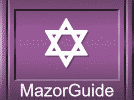|
• The Bride's
Reception
• Bedeken – Veiling the Bride Blessing
the Groom
• The Bedeken Ceremony – Veiling the
Bride
• Bedeken Music
• Blessing the Bride
• The "Deck-Tichel
(thick veil)
The Bride’s Reception
Brides reign on the wedding day, from their special throne-like decorated chairs. At many weddings, the bride’s throne is stationed atop risers, adding loftiness to the regal treatment. Perched on her chair, the bride greets the stream of guests making their way to wish her a mazal tov and lots of happiness.
During the greeting period, a buffet of hors d’oeuvres, bountiful veggie and dip trays, as well as pick offerings off platters carried by waiters, is offered the participating guests. Ice sculptures, string quartets, stuffed crepe creators, pasta stations, fresh pastrami carving tables, there seems to be no limit to the food at a smorgasbord, affectionately known as the “shmorg.”
Shmorg setups vary according to budget and preference. Aside from offering salads instead of the fearlessly cholesterol-rich food, some couples choose to offer only drinks during this gathering (Jewish style cocktail hour) and to feed the crowd after the ceremony while the newlyweds are snapping post-ceremony pictures.
Lavish arrays may stem from the feast Eliezer was served by Rebecca’s family before he brought Rebecca home to marry his master’s son Isaac. (Genesis 24:54)
Brides, who are often fasting, may not relish the smells of rich food around them. But the custom to complete saying the Book of Psalms, Tehillim, offers a spiritually elevating distraction.
Bedeken – Veiling the Bride
Blessing the Groom
At some weddings, just before the he sets off the veil the bride, the groom is blessed by his parents and others such as his rabbi, teachers, friends and relatives.
It is customary in some communities for the one blessing the groom to lay hands on the head of the groom’s head. Personal blessings are appropriate as is the traditional blessing customarily given to sons in some homes on Friday night or on the eve of Yom Kippur.
"Yesimcha Elokim k’Ephraim u’Menashe”
“May G-d make you like Ephraim and Menashe.”
Ephraim and Menashe were Joseph’s two sons. Hence many wonder why aren’t boy’s blessed as it traditionally accepted to bless daughters, that they should become like the matriarchs, Sarah, Rivka, Rachel and Leah?. Answers abound, however a popular states that it is because Ephraim and Menashe were born in Egypt outside of the holy atmosphere of Israel and away from the rest of Joseph’s family in Israel: Jacob and his other sons who would become the tribes of Israel. But despite being away from the holiness of Israel and the directly influence of Jacob, they were the only grandchildren who were included as progenitors of tribes of their own. This is evidence of Ephraim and Menashe’s great determination and commitment, as they overcame barriers and maintained a holy demeanor even in the decadent land of Egypt.
The Bedeken Ceremony – Veiling the Bride
After the ketubah is signed, the groom approaches his bride and lowers the veil over her face in a ceremony called a bedeken. Hearts quicken as the first notes of the bedeken music sound. The moment is really here. The promise of love, and the reality of the commitment hang in the air. After years of dreaming and months of planning. The groom approaches.
Brides in Talmudic times wore veils over their faces (Ketubot 17b). Many explanations are given for this custom. A groom who covers his bride’s face shows his interest in her goes far beyond physical beauty. He is attracted to the beauty within.
The veiled brides are likened to Rebecca the matriarch, who drew a veil across her face when she encountered her husband-to-be, Isaac, for the first time. Women are captains of the home front, the intimacy she will initiate within the home is strengthened as she shields her family from the winds of spiritual and emotional discord. In this sense, the veil of modesty is not just a pledge of chastity, but a symbol of dignity and strength.
Practical halacha requires the veil as a symbol of marriage. One of the ways a husband marries a woman is through a chuppah. Some interpret the chuppah as the familiar wedding canopy. Others define chuppah as setting up a home for his wife, symbolized by the husband’s provision of a garment to cover his wife; a role filled by the veil.
Bedeken Music
Diversity rules the choice of bedeken music. Wildly rhythmic upbeat music lightens the step of some grooms who swoop in to a fast-paced melody. Friends act as a royal, rowdy entourage accompanying the groom to his beloved.
Lyrics to a common bedeken song come from the Book of Psalms:
“Vayehi b’yeshurun melech b’hitahsayf roshei ahm, yach eem shivtey yisrael. Od yishama b’arei Yehuda oo’behchootzoat Yerushalayim. Kol sah-soan, v’kol simcha, kol chatan, v’kol kallah.” (Psalms)
“And it was when there was a king in Yeshurun that all the people were gathered together. All the tribes of Isarel together. There shall once again be heard in the cities of Judea and in the outskirts of Jerusalem, a sound of joy, a sound of gladness, a sound of the bridegroom, a sound of the bride.”
At a Lubavitch chassidic wedding, the mood is entirely different. A wordless melody, known as the “Alter Rebbe’s Niggun of Four Stanzas” is sung. Composed by Rabbi Schneur Zalman of Liadi (1745-1812), this niggun is sung only at weddings and other special occasions. As the bride and groom walk down the aisle, the niggun continues to be sung.
Blessing the Bride
After the veil is in place parents, parents-in-law, and others approach the bride and bless her with personal words and wishes or the words said to Rebecca as she left her father’s home to marry Isaac followed by the more traditional blessing that invokes the four matriarchs as role models. In addition, the bride is often blessed with three part blessing of the kohanim, descendants of the priestly class.
.“Achoteinu aht hayee l’allfay rehvavah, vahyirash zahrahcha eht she’ar soanav.
“Our sister, may you be the mother of thousands and tens of thousands. And may your children possess the gate of those who hate them.” (Genesis 24:60)
“Yesimcha Elokim k’Sarah, Rivka, Rachel, V’Leah.”
“May God make you like Sara, Rebecca, Rachel and Leah.”
“Yevarechecha Ad-nai v’yishmerecha, ya-air Ad-nai panav aylecha v’yeechunecha, yeesah Ad-nai panav aylecha v’yahsame lecha shalom.”
“May God bless you and keep you. May God make His face shine upon you and be gracious to you. May God lift His countenance upon you and grant you peace.”
Thick Veil
In some chassidic circles, the bride is veiled with an opaque deck tichel, veiling cloth, in additional to the usual gossamer-light veil. Explanations surrounding this custom include a reference to a Midrash commentary about Moses. Once he descended from Mt. Sinai, he radiated such an intense divine glow that he wore a veil to shield others from being “blinded” by the light. Brides, on the way to and under the chuppah, are said to be graced with Divine presence. The veil also reminds them of their closeness, and creates a private space for the bride to relate to God without distractions.
Others interpret the veil as a statement of the bride’s faith in her husband. She enters a marriage without seeing her ring, without judging her husband on the material wealth. Another explanation based on the Zohar is in a similar vein. Rabbi Aryeh Kaplan relates, the bride represents the Children of Israel who are likened to a ‘beautiful girl without eyes.’ Just as the Jewish people are at their best when they follow God without questions, a marriage is blessed where a woman can have such complete faith in her husband.


|







